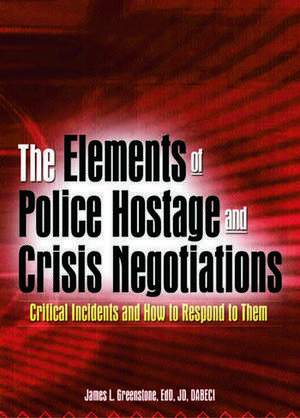The Elements of Police Hostage and Crisis Negotiations: Critical Incidents and How to Respond to Them
Autor James L. Greenstoneen Limba Engleză Paperback – 13 ian 2005
Run a safe and successful crisis negotiation—from start to finish!
The Elements of Police Hostage and Crisis Negotiations: Critical Incidents and How to Respond to Them reduces the negotiation procedures for hostage, barricaded, and suicide incidents to their basic elements, providing quick and easy access to the information you need-from the initial call-out to the final debriefing. Based on field-tested principles proven to work, the book also includes newly developed and highly specialized techniques for more experienced negotiators. Author James L. Greenstone provides a user-friendly, step-by-step guide to the intervention and negotiation process that will help you get the job done—right.
Designed for day-to-day, on-the-scene use, The Elements of Police Hostage and Crisis Negotiations is a practical handbook for experienced professionals and novices that can also be used as a supplementary textbook for criminal justice, crisis intervention, and psychology coursework. Each chapter contains useful checklists, procedural notes, tables, strategy worksheets, and forms, and the book includes special indices for quick reference in addition to a traditional index. Dr. Greenstone, a police mental health consultant and psychologist who served as Director of the Psychological Services Unit of the Fort Worth Police Department in Texas, uses a simple and direct format that emphasizes procedures, action and results, leaving theoretical discussions for another time and place. The book examines the negotiation process from start to finish, including preincident preparations, first response responsibilities, responding to the call-out, arriving at the scene, preparing to negotiate, making contact, preparing for the surrender, post-incident tasks, preparing equipment, and more.
Topics covered in The Elements of Police Hostage and Crisis Negotiations include:
- legal considerations
- telephone surveillance guidelines
- the Stockholm Syndrome
- working with S.W.A.T. and Tactical Emergency Medical Support
- dealing with the media
- recognizing “red flags”
- the issues of suicide
- debriefing the hostage team
- the 150 laws of hostage and crisis negotiation
- and the 10 most serious errors a negotiator can make
The Elements of Police Hostage and Crisis Negotiations: Critical Incidents and How to Respond to Them is a practical guide that’s equally effective in the field, in training, and in the office.
| Toate formatele și edițiile | Preț | Express |
|---|---|---|
| Paperback (1) | 326.32 lei 6-8 săpt. | |
| Taylor & Francis – 13 ian 2005 | 326.32 lei 6-8 săpt. | |
| Hardback (1) | 764.62 lei 6-8 săpt. | |
| Taylor & Francis – 18 ian 2005 | 764.62 lei 6-8 săpt. |
Preț: 326.32 lei
Preț vechi: 372.20 lei
-12% Nou
62.46€ • 67.87$ • 52.50£
Carte tipărită la comandă
Livrare economică 21 aprilie-05 mai
Specificații
ISBN-10: 0789018969
Pagini: 270
Dimensiuni: 148 x 210 x 17 mm
Greutate: 0.5 kg
Ediția:1
Editura: Taylor & Francis
Colecția Routledge
Locul publicării:Oxford, United Kingdom
Cuprins
- Foreword (H. H. A. Cooper)
- Preface
- Acknowledgments
- Chapter 1. Preincident Preparation
- Select Negotiators
- Establish Selection Timeline
- Use the Decision Tree
- Develop General Orders and Standard Operating Procedures
- Deal with the Media
- Chapter 2. First-Response Duties
- Follow the Steps for First Response
- Develop Intelligence at the Scene
- Gather Important Information Immediately in Hostage and Barricade Situations
- Chapter 3. Callout Response
- Keep Equipment Prepared
- Prepare Your Family
- Prepare Yourself
- Respond to the Scene
- Report to the Command Post
- Chapter 4. Arriving on Scene and Setting Up
- Organize Personnel at the Scene
- Remain Aware of Legal Considerations
- Observe Telephone Surveillance Guidelines and Laws
- Set Up Telephone or Other Communication System
- Chapter 5. Preparing to Negotiate
- Review Information on the Abnormal Psychology of Hostage Takers
- Review Negotiations Strategies
- Chapter 6. Making Contact and Beginning Negotiations
- Know the Stages of Negotiations
- Review the Greenstone Model of Crisis Intervention
- Determine Whether You Have a Hostage or Crisis Situation
- Review the Basic Steps for Contact with the Hostage Taker
- Use Boards
- Ignore Deadlines, but Be Prepared to Explain
- Listen for Demands
- Prepare for Face-to-Face Negotiations
- Set Goals for Negotiations
- Remember That Negotiations Are a Team Effort
- Keep the Subject in Problem-Solving Mode
- Determine Whether You Are Making Progress
- Know How to Use the Pat Words and Phrases
- Go Step by Step
- Understand and Use Stockholm Syndrome
- The Dos and Don’ts for Hostage and Crisis Negotiators
- Use Time Appropriately
- Understand Why We Do Not Trade Hostages
- Use Translators Appropriately and Effectively
- Know When and How to Call a Time-Out
- Select a Mental Health Professional to Assist the Team
- Be a Mental Health Consultant to a Negotiations Team
- Chapter 7. Preparing for the Surrender
- Understand and Develop the Process
- Use the Guidelines
- Chapter 8. Postincident Tasks
- Debrief the Hostage Negotiations Team
- Use the Debriefing Sheet
- Review the Ten Most Serious Errors
- Illustrative Case Study: Why Did It Work?
- Chapter 9. Attending to Special Issues
- Consider Risk Factors
- Utilize the Violence Risk Analysis Worksheet
- Review Red Flag Indicators and Pay Attention to Them
- Know When to Terminate Utilities
- Know How to Win and Lose As a Team
- Know How to Survive if You Are Taken Hostage
- Consider the Role of Tactical Emergency Medical Support for Negotiators
- Chapter 10. Specific Issues Relating to Suicide
- Review the Procedures for Responding to a Suicidal Subject
- Know How to Use the Lethality Scale
- Recognize a “Suicide by Cop”: Victim-Precipitated Suicide
- Confronting Adolescent Suicide
- Chapter 11. Developing Negotiator Survival Skills
- Use Self-Relaxation Skills
- Understand the Signs of Job Stress and Burnout
- Develop Personal Survival Skills
- Chapter 12. Learning and Using Effective Communication Skills
- Ask the Right Questions
- Understand the Messages
- Understand the Nature of Distortions
- Be Empathetic
- Never Assume
- Clarify Statements
- Know When and How to Ask Questions
- Deal Effectively with Silence
- Understand Content and Feelings
- Respond to the Subje
Descriere
Run a safe and successful crisis negotiation—from start to finish!
The Elements of Police Hostage and Crisis Negotiations: Critical Incidents and How to Respond to Them reduces the negotiation procedures for hostage, barricaded, and suicide incidents to their basic elements, providing quick and easy access to the information you need-from the initial call-out to the final debriefing. Based on field-tested principles proven to work, the book also includes newly developed and highly specialized techniques for more experienced negotiators. Author James L. Greenstone provides a user-friendly, step-by-step guide to the intervention and negotiation process that will help you get the job done—right.
Designed for day-to-day, on-the-scene use, The Elements of Police Hostage and Crisis Negotiations is a practical handbook for experienced professionals and novices that can also be used as a supplementary textbook for criminal justice, crisis intervention, and psychology coursework. Each chapter contains useful checklists, procedural notes, tables, strategy worksheets, and forms, and the book includes special indices for quick reference in addition to a traditional index. Dr. Greenstone, a police mental health consultant and psychologist who served as Director of the Psychological Services Unit of the Fort Worth Police Department in Texas, uses a simple and direct format that emphasizes procedures, action and results, leaving theoretical discussions for another time and place. The book examines the negotiation process from start to finish, including preincident preparations, first response responsibilities, responding to the call-out, arriving at the scene, preparing to negotiate, making contact, preparing for the surrender, post-incident tasks, preparing equipment, and more.
Topics covered in The Elements of Police Hostage and Crisis Negotiations include:
- legal considerations
- telephone surveillance guidelines
- the Stockholm Syndrome
- working with S.W.A.T. and Tactical Emergency Medical Support
- dealing with the media
- recognizing “red flags”
- the issues of suicide
- debriefing the hostage team
- the 150 laws of hostage and crisis negotiation
- and the 10 most serious errors a negotiator can make
The Elements of Police Hostage and Crisis Negotiations: Critical Incidents and How to Respond to Them is a practical guide that’s equally effective in the field, in training, and in the office.






















